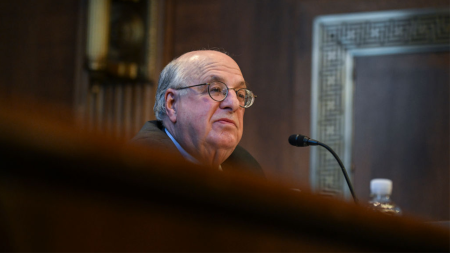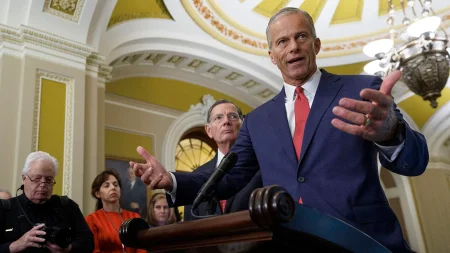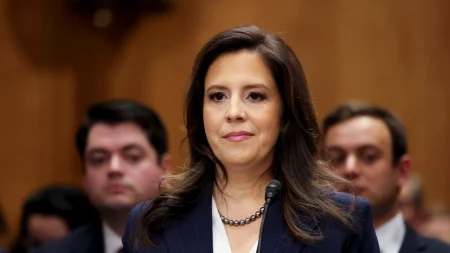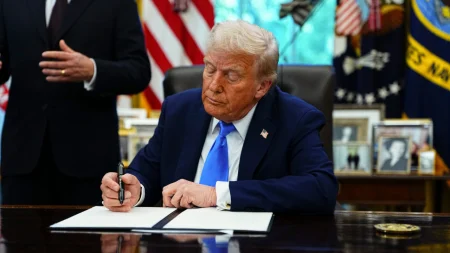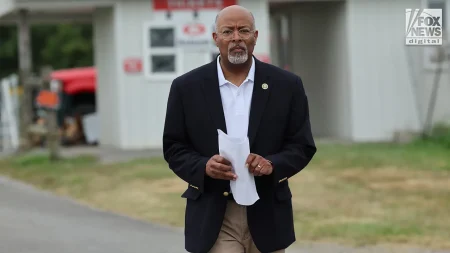The Supreme Court’s Delicate Balance: Trump’s Tariff Powers Under Scrutiny
In a case that could significantly reshape the boundaries of presidential power, the Supreme Court is currently deliberating whether Donald Trump’s global tariff initiative overstepped constitutional boundaries. During nearly three hours of oral arguments, justices from across the ideological spectrum expressed concerns about the separation of powers, particularly questioning the absence of Congressional involvement in what Trump has characterized as a matter of “life or death” for the nation. The central question revolves around whether a president can unilaterally impose sweeping tariffs on major trading partners worldwide, bypassing Congress’s traditional role in approving taxes and tariffs, by invoking emergency powers. The implications reach far beyond Trump’s presidency, potentially redefining the balance of power between branches of government for generations to come.
The Court’s questioning revealed particular interest in two legal principles that could potentially doom Trump’s position: the major questions doctrine and the non-delegation doctrine. Justice Clarence Thomas opened the proceedings by asking Solicitor General John Sauer, representing Trump, why the major questions doctrine wouldn’t apply in this case. This doctrine requires clear statutory authorization for executive actions of major national significance, which worldwide tariffs would certainly qualify as. Sauer argued that because the tariffs involve foreign trade, an area where presidents traditionally receive greater deference, the doctrine was “a particularly poor fit.” However, several justices challenged this reasoning, noting that recent Supreme Court decisions have increasingly required explicit statutory permission for significant policies, regardless of which branch implements them. The fact that the 1977 International Emergency Economic Powers Act (IEEPA), which Trump invoked, never even mentions the word “tariffs” seemed particularly troubling to the Court.
Justices from both liberal and conservative backgrounds found common ground in questioning the president’s authority in this case. In a notable exchange, Trump appointee Amy Coney Barrett and Obama appointee Sonia Sotomayor joined forces to press Sauer on how IEEPA could authorize tariffs when it only grants the president power to “regulate imports” but doesn’t explicitly mention tariffs. Justice Neil Gorsuch, another Trump appointee, took the questioning further by asking whether Congress could “delegate to the president the power to regulate commerce with foreign nations as he sees fit,” hinting at concerns about the non-delegation doctrine. This principle questions whether Congress can constitutionally transfer its core legislative functions, like taxing authority, to another branch without clear limitations. The justices appeared to be weighing whether interpreting IEEPA to permit presidential tariffs would effectively hand Congress’s constitutional responsibilities to the executive branch without adequate constraints.
Trump has not been quiet about what he perceives as the enormous stakes involved in this case. In social media posts this week, he claimed that if the Court deems his tariffs illegal, the potential refund process could exceed $3 trillion, creating what he called an “insurmountable National Security Event, and devastating to the future of our Country.” Trump has regularly highlighted the billions in revenue collected through these tariffs, proposing to use these funds to provide $2,000 payments to lower-income families and to reduce the national debt. His impassioned rhetoric suggests he may be bracing for an unfavorable ruling, as legal experts note that the Court’s questioning revealed significant skepticism about the president’s position. Brent Skorup from the CATO Institute, which has sided against Trump, observed that while the Court has historically been deferential to presidents on foreign policy matters, the recent trend of applying the major questions doctrine more stringently could prevail in this case.
The Supreme Court now faces two potential paths forward if they rule against Trump. The first would involve interpreting IEEPA narrowly to avoid concluding that Congress improperly delegated its constitutional tariff authority to the president. This approach, favored by legal scholars like University of Minnesota law professor Ilan Wurman, would allow the Court to resolve the immediate case without directly confronting the more sweeping constitutional questions about delegation of powers. Alternatively, the Court could directly address the non-delegation doctrine, potentially declaring that Congress cannot constitutionally transfer such fundamental powers to the executive branch without specific guidelines and limitations. As Wurman colorfully noted, “every century or so the Supreme Court should strike something down under the non-delegation doctrine. Give it a little life here and there.”
The implications of this case extend far beyond the specific tariffs at issue. A ruling against Trump could significantly constrain not just his ability to implement his economic agenda if reelected but would limit presidential power for future administrations as well. Conversely, a ruling in Trump’s favor would represent a substantial expansion of executive authority, potentially allowing presidents to bypass Congress on a range of economic and trade issues by declaring national emergencies. Chief Justice John Roberts’ questioning during arguments suggested he sees potential “major questions” problems with Trump’s position, which could indicate the direction the Court is leaning. With a decision expected by late June, this ruling will likely have profound effects on the separation of powers and the ability of future presidents to unilaterally shape economic policy. As the nation waits for this consequential decision, the Court continues its careful deliberation on where exactly to draw the line between presidential authority and congressional prerogative.






